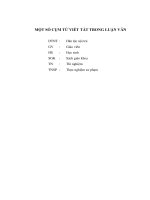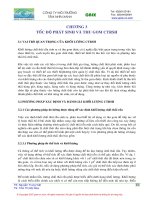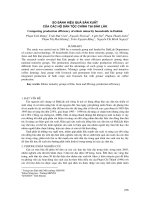1011 toc
Bạn đang xem bản rút gọn của tài liệu. Xem và tải ngay bản đầy đủ của tài liệu tại đây (520.21 KB, 12 trang )
Table of Contents
iii
Table of Contents
Preface
Acknowledgment
xv
xvii
1 INTRODUCTION
1.1 Expectations from fillers
1.2 Typical filler properties
1.3 Definitions
1.4 Classification
1.5 Markets and trends
References
1
1
7
8
11
12
13
2
SOURCES OF FILLERS, THEIR CHEMICAL
COMPOSITION, PROPERTIES, AND MORPHOLOGY
2.1 Particulate fillers
2.1.1 Aluminum flakes and powder
2.1.2 Aluminum borate whiskers
2.1.3 Aluminum oxide
2.1.4 Aluminum trihydroxide
2.1.5 Anthracite
2.1.6 Antimony of sodium
2.1.7 Antimony pentoxide
2.1.8 Antimony trioxide
2.1.9 Apatite
2.1.10 Ash, fly
2.1.11 Attapulgite
2.1.12 Barium metaborate
2.1.13 Barium sulfate
2.1.14 Barium & strontium sulfates
2.1.15 Barium titanate
2.1.16 Bentonite
2.1.17 Beryllium oxide
2.1.18 Boron nitride
2.1.19 Calcium carbonate
2.1.20 Calcium hydroxide
2.1.21 Calcium sulfate
2.1.22 Carbon black
2.1.23 Ceramic beads
15
16
16
19
20
22
25
26
27
29
31
32
33
35
36
41
42
43
45
46
48
58
60
62
72
iv
2.1.24
2.1.25
2.1.26
2.1.27
2.1.28
2.1.29
2.1.30
2.1.31
2.1.32
2.1.33
2.1.34
2.1.35
2.1.36
2.1.37
2.1.38
2.1.39
2.1.40
2.1.41
2.1.42
2.1.43
2.1.44
2.1.45
2.1.46
2.1.47
2.1.48
2.1.49
2.1.50
2.1.51
2.1.51.1
2.1.51.2
2.1.51.3
2.1.51.4
2.1.51.5
2.1.51.6
2.1.52
2.1.53
2.1.54
2.1.55
2.1.56
2.1.57
2.1.58
2.1.59
Table of Contents
Clay
Copper
Cristobalite
Diatomaceous earth
Dolomite
Ferrites
Feldspar
Glass beads
Gold
Graphite
Hydrous calcium silicate
Iron oxide
Kaolin
Lithopone
Magnesium oxide
Magnesium hydroxide
Metal-containing conductive materials
Mica
Molybdenum
Molybdenum disulfide
Nickel
Perlite
Polymeric fillers
Pumice
Pyrophyllite
Rubber particles
Sepiolite
Silica
Fumed silica
Fused silica
Precipitated silica
Quartz (tripoli)
Sand
Silica gel
Silver powder and flakes
Slate flour
Talc
Titanium dioxide
Tungsten
Vermiculite
Wood flour and similar materials
Wollastonite
75
77
78
80
84
85
86
87
91
92
96
97
99
104
105
106
107
112
116
117
118
120
122
127
128
129
130
131
132
138
139
142
144
146
147
149
150
154
164
165
166
167
Table of Contents
2.1.60 Zeolites
2.1.61 Zinc borate
2.1.62 Zinc oxide
2.1.63 Zinc stannate
2.1.64 Zinc sulfide
2.2 Fibers
2.2.1 Aramid fibers
2.2.2 Carbon fibers
2.2.3 Cellulose fibers
2.2.4 Glass fibers
2.2.5 Other fibers
References
v
170
171
172
175
176
178
178
180
184
187
188
189
3
TRANSPORTATION, STORAGE, AND PROCESSING OF
FILLERS
3.1 Filler packaging
3.2 External transportation
3.3 Filler receiving
3.4 Storage
3.5 In-plant conveying
3.6 Semi-bulk unloading systems
3.7 Bag handling equipment
3.8 Blending
3.9 Feeding
3.10 Drying
3.11 Dispersion
References
203
203
205
206
208
210
215
216
217
218
220
222
227
4 QUALITY CONTROL OF FILLERS
4.1 Absorption coefficient
4.2 Acidity or alkalinity of water extract
4.3 Ash content
4.4 Brightness
4.5 Coarse particles
4.6 Color
4.7 CTAB surface area
4.8 DBP absorption number
4.9 Density
4.10 Electrical properties
4.11 Extractables
4.12 Fines content
231
231
231
231
232
232
232
232
233
233
233
234
234
vi
4.13
4.14
4.15
4.16
4.17
4.18
4.19
4.20
4.21
4.22
4.23
4.24
4.25
4.26
4.27
4.28
4.29
4.30
4.31
4.32
4.33
4.34
4.35
Table of Contents
Heating loss
Heat stability
Hegman fineness
Hiding power
Iodine absorption number
Lightening power of white pigments
Loss on ignition
Mechanical and related properties
Oil absorption
Particle size
Pellet strength
pH
Resistance to light
Resistivity of aqueous extract
Sieve residue
Soluble matter
Specific surface area
Sulfur content
Tamped volume
Tinting strength
Volatile matter
Water content
Water-soluble sulfates, chlorides and nitrates
References
PHYSICAL PROPERTIES OF FILLERS AND FILLED
MATERIALS
5.1 Density
5.2 Particle size
5.3 Particle size distribution
5.4 Particle shape
5.5 Particle surface morphology and roughness
5.6 Specific surface area
5.7 Porosity
5.8 Particle-particle interaction and spacing
5.9 Agglomerates
5.10 Aggregates and structure
5.11 Flocculation and sedimentation
5.12 Aspect ratio
5.13 Packing volume
5.14 pH
5.15 ζ-potential
234
234
234
234
235
235
235
235
235
236
236
236
236
236
237
237
237
237
237
238
238
238
238
239
5
241
241
245
246
251
251
253
254
255
257
259
261
263
264
269
270
Table of Contents
5.16
5.17
5.18
5.19
5.20
5.21
5.22
5.23
5.24
5.25
5.26
5.27
5.28
5.29
5.30
5.31
Surface energy
Moisture
Absorption of liquids and swelling
Permeability and barrier properties
Oil absorption
Hydrophilic/hydrophobic properties
Optical properties
Refractive index
Friction properties
Hardness
Intumescent properties
Thermal conductivity
Thermal expansion coefficient
Melting temperature
Electrical properties
Magnetic properties
References
CHEMICAL PROPERTIES OF FILLERS AND
FILLED MATERIALS
6.1 Reactivity
6.2 Chemical groups on the filler surface
6.3 Filler surface modification
6.4 Effect of filler modification on material properties
6.5 Resistance to various chemical materials
6.6 Cure in filler's presence
6.7 Polymerization in filler's presence
6.8 Grafting
6.9 Crosslink density
6.10 Reaction kinetics
6.11 Molecular mobility
References
vii
271
275
278
280
280
281
284
285
286
287
288
289
290
291
291
295
297
6
7
7.1
7.2
7.3
7.4
7.5
7.6
7.7
ORGANIZATION OF INTERFACE AND MATRIX
CONTAINING FILLERS
Particle distribution in matrix
Orientation of filler particle in a matrix
Voids
Matrix-filler interaction
Chemical interactions
Other interactions
Interphase organization
305
305
308
312
324
330
331
336
337
338
339
341
343
347
347
351
356
358
359
363
367
viii
7.8
7.9
7.10
7.11
7.12
7.13
7.14
7.15
Table of Contents
Interfacial adhesion
Interphase thickness
Filler-chain links
Chain dynamics
Bound rubber
Debonding
Mechanisms of reinforcement
Benefits of organization on molecular level
References
THE EFFECT OF FILLERS ON THE MECHANICAL
PROPERTIES OF FILLED MATERIALS
8.1 Tensile strength and elongation
8.2 Tensile yield stress
8.3 Elastic
8.4 Flexural strength and modulus
8.5 Impact resistance
8.6 Hardness
8.7 Tear strength
8.8 Compressive strength
8.9 Fracture resistance
8.10 Wear
8.11 Friction
8.12 Abrasion
8.13 Scratch resistance
8.14 Fatigue
8.15 Failure
8.16 Adhesion
8.17 Thermal deformation
8.18 Shrinkage
8.19 Warpage
8.20 Compression set
8.21 Load transfer
8.22 Residual stress
8.23 Creep
References
369
370
372
373
374
380
384
389
392
8
THE EFFECT OF FILLERS ON RHEOLOGICAL
PROPERTIES OF FILLED MATERIALS
9.1 Viscosity
9.2 Flow
9.3 Flow induced filler orientation
395
395
402
407
410
412
414
417
418
419
426
429
430
432
433
440
442
444
444
448
449
451
453
454
455
9
461
461
465
468
Table of Contents
9.4
9.5
9.6
9.7
9.8
9.9
9.10
9.11
Torque
Viscoelasticity
Dynamic mechanical behavior
Complex viscosity
Shear viscosity
Elongational viscosity
Melt rheology
Yield value
References
ix
470
471
472
474
478
478
481
481
483
10 MORPHOLOGY OF FILLED SYSTEMS
10.1 Crystallinity
10.2 Crystallization behavior
10.3 Nucleation
10.4 Crystal size
10.5 Spherulites
10.6 Transcrystallinity
10.7 Orientation
References
485
485
487
490
492
493
495
497
498
11 EFFECT OF FILLERS ON DEGRADATIVE PROCESSES
11.1 Irradiation
11.2 UV radiation
11.3 Temperature
11.4 Liquids and vapors
11.5 Stabilization
11.6 Degradable materials
References
501
501
505
510
512
516
517
518
12 ENVIRONMENTAL IMPACT OF FILLERS
12.1 Definitions
12.2 Limiting oxygen index
12.3 Ignition and flame spread rate
12.4 Heat transmission rate
12.5 Decomposition and combustion
12.6 Emission of gaseous components and heavy metals
12.7 Smoke
12.8 Char
12.9 Recycling
References
521
521
522
523
527
527
530
531
531
531
536
x
Table of Contents
13 INFLUENCE OF FILLERS ON PERFORMANCE OF
OTHER ADDITIVES AND VICE VERSA
13.1 Adhesion promoters
13.2 Antistatics
13.3 Blowing agents
13.4 Catalysts
13.5 Compatibilizers
13.6 Coupling agents
13.7 Dispersing agents and surface active agents
13.8 Flame retardants
13.9 Impact modifiers
13.10 UV stabilizers
13.11 Other additives
References
539
539
541
541
543
544
545
547
549
551
552
554
555
14 TESTING METHODS IN FILLED SYSTEMS
14.1 Physical methods
14.1.1 Atomic force microscopy
14.1.2 Autoignition test
14.1.3 Bound rubber
14.1.4 Char formation
14.1.5 Cone calorimetry
14.1.6 Contact angle
14.1.7 Dispersing agent requirement
14.1.8 Dispersion tests
14.1.9 Dripping test
14.1.10 Dynamic mechanical analysis
14.1.11 Electrical constants determination
14.1.12 Electron microscopy
14.1.13 Fiber orientation
14.1.14 Flame propagation test
14.1.15 Glow wire test
14.1.16 Image analysis
14.1.17 Limiting oxygen index
14.1.18 Magnetic properties
14.1.19 Optical microscopy
14.1.20 Particle size analysis
14.1.21 Radiant panel test
14.1.22 Rate of combustion
14.1.23 Scanning acoustic microscopy
14.1.24 Smoke chamber
14.1.25 Sonic methods
559
559
559
560
560
561
562
563
565
566
567
568
568
571
572
572
574
574
577
578
579
580
580
580
581
581
582
Table of Contents
xi
14.1.26 Specific surface area
14.1.27 Thermal analysis
14.2 Chemical and instrumental analysis
14.2.1 Electron spin resonance
14.2.2 Electron spectroscopy for chemical analysis
14.2.3 Inverse gas chromatography
14.2.4 Gas chromatography
14.2.5 Gel content
14.2.6 Infrared and Raman spectroscopy
14.2.7 Nuclear magnetic resonance spectroscopy
14.2.8 UV and visible spectrophotometry
14.2.9 X-ray analysis
14.2.10 X-ray photoelectron Spectroscopy
References
584
585
586
586
587
588
592
592
593
594
597
598
598
599
15 FILLERS IN COMMERCIAL POLYMERS
15.1 Acrylics
15.2 Acrylonitrile-butadiene-styrene copolymer
15.3 Acrylonitrile-styrene-acrylate
15.4 Aliphatic polyketone
15.5 Alkyd resins
15.6 Elastomers
15.7 Epoxy resins
15.8 Ethylene vinyl acetate copolymers
15.9 Ethylene ethyl acetate copolymer
15.10 Ethylene propylene copolymers
15.11 Ionomers
15.12 Liquid crystalline polymers
15.13 Perfluoroalkoxy resin
15.14 Phenolic resins
15.15 Poly(acrylic acid)
15.16 Polyamides
15.17 Polyamide imide
15.18 Polyamines
15.19 Polyaniline
15.20 Polyarylether ketone
15.21 Poly(butylene terephthalate)
15.22 Polycarbonate
15.23 Polyetheretherketone
15.24 Polyetherimide
15.25 Polyether sulfone
15.26 Polyethylene
605
606
608
610
611
612
613
614
619
620
621
622
623
624
625
628
629
633
634
635
636
638
639
642
644
645
646
xii
Table of Contents
15.27 Polyethylene, chlorinated
15.28 Polyethylene, chlorosulfonated
15.29 Poly(ethylene oxide)
15.30 Poly(ethylene terephthalate)
15.31 Polyimide
15.32 Polymethylmethacrylate
15.33 Polyoxymethylene
15.34 Poly(phenylene ether)
15.35 Poly(phenylene sulfide)
15.36 Polypropylene
15.37 Polypyrrole
15.38 Polystyrene & high impact
15.39 Polysulfides
15.40 Polysulfone
15.41 Polytetrafluoroethylene
15.42 Polyurethanes
15.43 Poly(vinyl acetate)
15.44 Poly(vinyl alcohol)
15.45 Poly(vinyl butyral)
15.46 Poly(vinyl chloride)
15.47 Rubbers
15.47.1 Natural rubber
15.47.2 Nitrile rubber
15.47.3 Polybutadiene rubber
15.47.4 Polybutyl rubber
15.47.5 Polychloroprene
15.47.6 Polyisobutylene
15.47.7 Polyisoprene
15.47.8 Styrene-butadiene rubber
15.48 Silicones
15.49 Styrene acrylonitrile copolymer
15.50 Tetrafluoroethylene-perfluoropropylene
15.51 Unsaturated polyesters
15.52 Vinylidene-fluoride terpolymers
References
651
652
653
655
656
658
660
661
662
663
668
669
672
673
674
676
679
680
681
682
684
685
687
690
691
692
694
695
696
698
700
701
702
704
705
16 FILLER IN MATERIALS COMBINATIONS
16.1 Blends, alloys and interpenetrating networks
16.2 Composites
16.3 Nanocomposites
16.4 Laminates
References
717
717
726
730
736
737
Table of Contents
xiii
17 FORMULATION WITH FILLERS
References
741
746
18 FILLERS IN DIFFERENT PROCESSING METHODS
18.1 Blow molding
18.2 Calendering and hot-melt coating
18.3 Compression molding
18.4 Dip coating
18.5 Dispersion
18.6 Extrusion
18.7 Foaming
18.8 Injection molding
18.9 Knife coating
18.10 Mixing
18.11 Pultrusion
18.12 Reaction injection molding
18.13 Rotational molding
18.14 Sheet molding
18.15 Thermoforming
18.16 Welding and machining
References
749
749
751
752
754
755
757
760
761
763
764
769
769
771
772
773
773
774
19 FILLERS IN DIFFERENT PRODUCTS
19.1 Adhesives
19.2 Agriculture
19.3 Aerospace
19.4 Appliances
19.5 Automotive materials
19.6 Bottles and containers
19.7 Building components
19.8 Business machines
19.9 Cables and wires
19.10 Coated fabrics
19.11 Coatings and paints
19.12 Cosmetics and pharmaceutical products
19.13 Dental restorative composites
19.14 Electrical and electronic materials
19.15 Electromagnetic interference shielding
19.16 Fibers
19.17 Film
19.18 Foam
19.19 Food and feed
779
779
782
782
783
784
785
786
786
787
788
788
793
795
796
797
799
799
802
802
xiv
Table of Contents
19.20
19.21
19.22
19.23
19.24
19.25
19.26
19.27
19.28
19.29
19.30
19.31
19.32
19.33
19.34
19.35
19.36
19.37
19.38
Friction materials
Geosynthetics
Hoses and pipes
Magnetic devices
Medical applications
Membranes
Noise damping
Optical devices
Paper
Radiation shields
Rail transportation
Roofing
Telecommunication
Tires
Sealants
Siding
Sports equipment
Waterproofing
Windows
References
20 HAZARDS IN FILLER USE
References
803
803
803
804
804
807
807
807
809
812
813
814
814
815
817
818
819
819
820
821
825
831
INDEX OF ABBREVIATIONS
833
DIRECTORY OF FILLER MANUFACTURERS AND
DISTRIBUTORS
837
DIRECTORY OF EQUIPMENT MANUFACTURERS
877
INDEX
881









